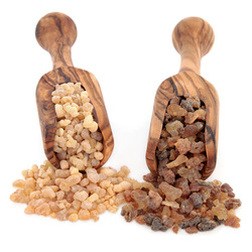 These two items show up all over the place in Christmas music. This verse from the modern carol “In the Silence” by Craig Courtney with words incorporating an Appalachian folk song is particularly pointed, as it includes the symbolism quite plainly:
These two items show up all over the place in Christmas music. This verse from the modern carol “In the Silence” by Craig Courtney with words incorporating an Appalachian folk song is particularly pointed, as it includes the symbolism quite plainly:
Why a gift for tombs they brought on this, the Savior’s birth?
You can see the word “incense” clearly in “frankincense.” That root word doesn’t refer to smell, as such, but to something being burned. We still say, “He was incensed” to mean, not that someone smelled good, but that he was burning with anger. Frankincense and myrrh are both aromatic resins from trees which grow mainly in North Africa and the Arabian Peninsula. In order to harvest both of these substances, workers slash the bark of the tree into the sapwood, allowing the resin to ooze out, and then scrape off the hardened chunks. These have a number of uses, the most common of which is to be burned and give off fragrance in connection with some type of worship. (So that’s the meaning of the line “frankincense for holy ones.”) But they also have had a place at funerals and in anointing oils. (There’s where the myrrh comes in as “a gift for tombs.”)Both items were and are quite expensive and thus have been associated with royalty and wealth, although poorer people have used them as much as they could afford to. Ancient cities sometimes used frankincense as a type of air purifier. If you found yourself walking down the streets of Imperial Rome you’d be pretty overwhelmed with the various stenches of garbage and sewage, but once in awhile, as you passed a statue of some emperor or god, you’d get a whiff of fragrant smoke, since incense burners were usually placed in front of them. The story is told that at the funeral of Sulla the dictator in 78 BC a whole statue of the deceased was made out of frankincense and other aromatics and set on fire to perfume the air during the ceremony. Alexander the Great apparently loved frankincense and was quite extravagant with it in his offerings at temples. His tutor disapproved, telling him that he should wait until he conquered the areas where it originated before using so much of it. So . . . of course Alexander did conquer those areas, and in an exquisitely fitting comeback he sent a huge amount of frankincense (and also quite a bit of myrrh) back to Macedonia with a message saying that the tutor now wouldn’t need to be so miserly in his dealings with the gods.There are some very interesting biblical associations with these substances, the most obvious being that they were used for the incense burned in Israel’s tabernacle and later temple. Even more fitting, perhaps, is that both of these fragrances are only obtained when the trees that produce them are wounded; the process of slashing the bark so that the resins will ooze out is often called “bleeding the trees.” So they can be seen as symbols of suffering as well as of worship. Christians believe that the book of Isaiah in the Jewish Bible, chapter 53, gives a similar picture of the suffering Messiah:
Surely he took up our pain and bore our suffering, yet we considered him punished by God, stricken by him, and afflicted. But he was pierced for our transgressions, he was crushed for our iniquities; the punishment that brought us peace was on him, and by his wounds we are healed. We all, like sheep, have gone astray, each of us has turned to our own way; and the Lord has laid on him the iniquity of us all.
As you look at, listen or sing the words to many traditional carols you’ll see the idea of Christ’s coming to set men free from sin occurring over and over. There’s great joy in the present but great sorrow to come, and this theme is carried out even in the rich offerings from these exotic and mysterious visitors.
So what did Mary and Joseph do with the gifts of the Magi? We don’t really know. There is one possibility, though, that makes a lot of sense: the gold, at least, but possibly the other two items, were used to finance the trip to Egypt that they made in order to escape Herod’s killing of all children under the age of two in order to get rid of the “King of the Jews” that the Magi had talked about. (The fact that Herod is going after toddlers and not just babies is another clue that tells us we’re not dealing with the birth of Christ here.) How else could they have made the journey? The Magi had no idea of all this as they opened their treasures and made their offerings. They did what they had come to do and left, vanishing from the record. Surely we can at least honor them by remembering their journey and sacrifice as we see the rows of “frankincense and myrrh” candles at the store!
Since I referenced a specific song in this post I wanted to include a video, which wasn’t easy to find. However, lo and behold, here’s a very recent virtual choir performance that’s pretty good!
© Debi Simons

